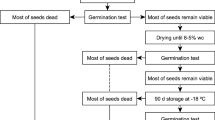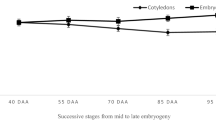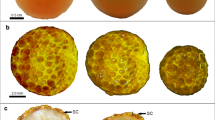Abstract
Key message
Seed desiccation sensitivity is not determined only by water content threshold but is a consequence of drying rate, which causes rapid viability loss, and this was associated to mechanical/physical damage
Abstract
Campomanesia xanthocarpa is a tree from Brazilian Atlantic Forest, one of the world’s biodiversity hotspots, that has potential as a model for studies on the physiological behavior of seeds susceptible to desiccation of tropical species. Desiccation sensitivity (DS) seeds are a major concern for ex situ conservation efforts and superficial inferences may generalize their behavior in a wider perspective. Although major physiological responses to stress are shared and relatively well understood, DS seeds responses can be highly variable. In addition, there is a lack of studies concerning DS seeds endogenous polyamines content, antioxidant activity and its relation to desiccation stress and seed viability. Seeds were desiccated and went through germination tests, histological analysis, and estimation of antioxidant enzymatic activity, lipid peroxidation and polyamines content. Due to inherent morphological features, the seeds have a high drying rate and rapidly lose viability within 24 h. During the first 6 h of drying 76% of initial water content is lost, but 96% of the seeds still germinated. Spermidine and H2O2-scaveging enzymes activity showed a positive correlation, endorsing polyamines antioxidant role. Although lipid peroxidation increased along seed drying, it was minimal and suggested to be an ongoing process when viability was lost. Due the intensity of tissue water loss it is likely that mechanical/physical damage led to seed viability loss. Assessing the nature of damage and physiological stress response mechanisms contribute to better understand species vulnerability and broad the knowledge of tropical seed behavior.






Similar content being viewed by others
References
Berjak P, Pammenter N (2008) From Avicennia to Zizania: seed recalcitrance in perspective. Ann Bot 101:213–228
Berjak P, Pammenter N (2013) Implications of the lack of desiccation tolerance in recalcitrant seeds. Front Plant Sci 4:478
Bradford MM (1976) A rapid and sensitive method for the quantitation of microgram quantities of protein utilizing the principle of protein-dye binding. Anal Biochem 72:248–254
Brasil (2009) Regras para análise de sementes. Ministério da Agricultura, Pecuária e Abastecimento, Brasília, Brasil
Calvi GP, Anjos AM, Kranner I, Pritchard HW, Ferraz ID (2017) Exceptional flooding tolerance in the totipotent recalcitrant seeds of Eugenia stipitata. Seed Sci Res 27:121–130
Chandra J, Keshavkant S (2018) Desiccation-induced ROS accumulation and lipid catabolism in recalcitrant Madhuca latifolia seeds. Physiol Mol Biol Plants 24:75–87
Chen Z, Lan Q, Zheng L, Bao Y, Luo Y (2015) Effects of dehydration and temperature on seed viability and antioxidative enzymes activities on three kinds of cultivars of Camellia sinensis. Braz J Bot 38:497–504
de Souza TV, Torres IC, Steiner N, Paulilo MTS (2015) Seed dormancy in tree species of the Tropical Brazilian Atlantic Forest and its relationships with seed traits and environmental conditions. Braz J Bot 38:243–264
Dekkers BJ, Costa MCD, Maia J, Bentsink L, Ligterink W, Hilhorst HW (2015) Acquisition and loss of desiccation tolerance in seeds: from experimental model to biological relevance. Planta 241:563–577
Delgado LF, Barbedo CJ (2007) Desiccation tolerance of seeds of species of Eugenia. Pesq Agrop Brasileira 42:265–272
Diversity CoB (2012) The global strategy for plant conservation: 2011–2020. Botanic Gardens Conservation International, London
Dousseau S, Alvarenga AAd, Mendes Guimarães R, Lara TS, Custódio TN, Chaves IdS (2011) Ecofisiologia da germinação de sementes de Campomanesia pubescens. Ciência Rural 41:1362–1368
Dresch DM, Masetto TE, Scalon SP (2015) Campomanesia adamantium (Cambess.) O. Berg seed desiccation: influence on vigor and nucleic acids. An Acad Bras Ciênc 87:2217–2228
Ellis R, Hong T, Roberts E (1990) An intermediate category of seed storage behaviour? I Coffee. J Exp Bot 41:1167–1174
Farrant JM, Moore JP (2011) Programming desiccation-tolerance: from plants to seeds to resurrection plants. Curr Opin Plant Biol 14:340–345
Ferrandis P, Bonilla M, del Carmen Osorio L (2011) Germination and soil seed bank traits of Podocarpus angustifolius (Podocarpaceae): an endemic tree species from Cuban rain forests. Rev Biol Trop 59:1061–1069
Giannopolitis CN, Ries SK (1977) Superoxide dismutases: I. Occurrence in higher plants. Plant Physiol 59:309–314
Gill SS, Tuteja N (2010) Reactive oxygen species and antioxidant machinery in abiotic stress tolerance in crop plants. Plant Physiol Biochem 48:909–930
Gogosz AM, Cosmo NL, Bona C, Souza LA (2010) Morfoanatomia da plântula de Campomanesia xanthocarpa O. Berg. (Myrtaceae). Acta Bot Bras 24:613–623
Gumilevskaya N, Azarkovich M (2007) Physiological and biochemical characteristics of the recalcitrant seeds having dormancy: a review. Appl Biochem Microbiol 43:332–340
Hill JP, Edwards W, Franks PJ (2010) How long does it take for different seeds to dry? Funct Plant Biol 37:575–583
Hill JP, Edwards W, Franks PJ (2012) Size is not everything for desiccation-sensitive seeds. J Ecol 100:1131–1140
Hodges DM, DeLong JM, Forney CF, Prange RK (1999) Improving the thiobarbituric acid-reactive-substances assay for estimating lipid peroxidation in plant tissues containing anthocyanin and other interfering compounds. Planta 207:604–611
Jiménez-Alfaro B, Silveira FA, Fidelis A, Poschlod P, Commander LE (2016) Seed germination traits can contribute better to plant community ecology. J Veg Sci 27:637–645
Koshiba T (1993) Cytosolic ascorbate peroxidase in seedlings and leaves of maize (Zea mays). Plant Cell Physiol 34:713–721
Landrum LR (1982) The development of the fruits and seeds of Campomanesia (Myrtaceae). Brittonia 34:220–224
Landrum LR, Kawasaki ML (1997) The genera of Myrtaceae in Brazil: an illustrated synoptic treatment and identification keys. Brittonia 49:508–536
Landrum LR, Stevenson D (1986) Variability of embryos in subtribe Myrtinae (Myrtaceae). Syst Bot 11:155–162
Leprince O, Pellizzaro A, Berriri S, Buitink J (2017) Late seed maturation: drying without dying. J Exp Bot 68:827–841
Liang Y, Sun WQ (2002) Rate of dehydration and cumulative desiccation stress interacted to modulate desiccation tolerance of recalcitrant cocoa and ginkgo embryonic tissues. Plant Physiol 128:1323–1331
Lisbôa GN, Kinupp VF, Barros IBI (2011) Campomanesia xanthocarpa (Guabiroba). In: Coradin L, Siminski A, Reis A (eds) Espécies Nativas da Flora Brasileira de Valor Econômico Atual ou Potencial: Plantas para o Futuro – Região Sul. Ministério do Meio Ambiente, Brasília
Liu J, Nakajima I, Moriguchi T (2011) Effects of salt and osmotic stresses on free polyamine content and expression of polyamine biosynthetic genes in Vitis vinifera. Biol Plant 55:340–344
Liu J-H, Wang W, Wu H, Gong X, Moriguchi T (2015) Polyamines function in stress tolerance: from synthesis to regulation. Front Plant Sci 6:827
Lucas EJ et al (2007) Suprageneric phylogenetics of Myrteae, the generically richest tribe in Myrtaceae (Myrtales). Taxon 56:1105–1128
Luo Y, Lan Q, Lu X, Chen Z, Tan Y (2012) Storage behaviour and antioxidant activities of Mimusops elengi seeds subjected to different drying rates. Seed Sci Technol 40:354–364
Maguire JD (1962) Speed of germination—aid in selection and evaluation for seedling emergence and vigor. Crop Sci 2:176–177
Maluf AM, Pisciottano-Ereio WA (2005) Desiccation and storage of cambuci seeds. Pesq Agrop Brasileira 40:707–714
Marques M, Joly CA (2000) Germinação e crescimento de Calophyllum brasiliense (Clusiaceae), uma espécie típica de florestas inundadas. Acta Botanica Brasilica 14:113–120
Marques A, Buijs G, Ligterink W, Hilhorst H (2018) Evolutionary ecophysiology of seed desiccation sensitivity. Funct Plant Biol 45:1083–1095
McVaugh R (1968) The genera of American Myrtaceae: an interim report. Taxon 17:354–418
Michel BE, Kaufmann MR (1973) The osmotic potential of polyethylene glycol 6000. Plant Physiol 51:914–916
Nunes D, Dresch D, Scalon S, Pereira Z (2015) Drying and reduction in sensitivity to desiccation of Campomanesia xanthocarpa seeds. Afr J Agric Res 10:2859–2865
O’Brien TP, Feder N, McCully ME (1965) Polychromatic staining of plant cell walls by toluidine blue O. Protoplasma 59:368–373
Parkhey S, Naithani S, Keshavkant S (2012) ROS production and lipid catabolism in desiccating Shorea robusta seeds during aging. Plant Physiol Biochem 57:261–267
Parvin S, Lee OR, Sathiyaraj G, Khorolragchaa A, Kim Y-J, Yang D-C (2014) Spermidine alleviates the growth of saline-stressed ginseng seedlings through antioxidative defense system. Gene 537:70–78
Paul S, Roychoudhury A (2017) Effect of seed priming with spermine/spermidine on transcriptional regulation of stress-responsive genes in salt-stressed seedlings of an aromatic rice cultivar. Plant Gene 11:133–142
Peixoto PHP, Cambraia J, Sant’Anna R, Mosquim PR, Moreira MA (1999) Aluminum effects on lipid peroxidation and on the activities of enzymes of oxidative metabolism in sorghum. Rev Bras Fisiol Veg 11:137–143
Quan LJ, Zhang B, Shi WW, Li HY (2008) Hydrogen peroxide in plants: a versatile molecule of the reactive oxygen species network. J Integr Plant Biol 50:2–18
R Core Team (2018) R:A language and environment for statistical computing. R foundation for statistical computing, Vienna, Austria
Roach T, Ivanova M, Beckett RP, Minibayeva FV, Green I, Pritchard HW, Kranner I (2008) An oxidative burst of superoxide in embryonic axes of recalcitrant sweet chestnut seeds as induced by excision and desiccation. Physiol Plant 133:131–139
Roberts EH (1973) Predicting the storage life of seeds. Seed Sci Technol 1:499–514
Rogge-Renner GD, Steiner N, Schmidt EC, Bouzon ZL, Farias FL, Guerra MP (2013) Structural and component characterization of meristem cells in Araucaria angustifolia (Bert.) O. Kuntze zygotic embryo. Protoplasma 250:731–739
Sahu B, Sahu A, Thomas V, Naithani S (2017) Reactive oxygen species, lipid peroxidation, protein oxidation and antioxidative enzymes in dehydrating Karanj (Pongamia pinnata) seeds during storage South African. J Bot 112:383–390
Steiner N, Santa-Catarina C, Silveira V, Floh EI, Guerra MP (2007) Polyamine effects on growth and endogenous hormones levels in Araucaria angustifolia embryogenic cultures. Plant Cell Tissue Organ Cult 89:55–62
Steiner N et al (2015) Toward establishing a morphological and ultrastructural characterization of proembryogenic masses and early somatic embryos of Araucaria angustifolia (Bert.) O. Kuntze. Protoplasma 253:487–501
Sudhakar C et al (2015) Polyamine metabolism influences antioxidant defense mechanism in foxtail millet (Setaria italica L.) cultivars with different salinity tolerance. Plant Cell Rep 34:141–156
Sun WQ (2002) Methods for the study of water relations under desiccation stress. In: Black M, Pritchard HW (eds) Desiccation and survival in plants: drying without dying, pp 47–91
Tiburcio AF, Altabella T, Bitrián M, Alcázar R (2014) The roles of polyamines during the lifespan of plants: from development to stress. Planta 240:1–18
Tweddle JC, Dickie JB, Baskin CC, Baskin JM (2003) Ecological aspects of seed desiccation sensitivity. J Ecol 91:294–304
Umarani R, Aadhavan EK, Faisal MM (2015) Understanding poor storage potential of recalcitrant seeds. Curr Sci 108:2023–2034
Varghese B, Berjak P, Varghese D, Pammenter NW (2011) Differential drying rates of recalcitrant Trichilia dregeana embryonic axes: a study of survival and oxidative stress metabolism. Physiol Plant 142:326–338
Vaz TA, Davide AC, Rodrigues-Junior AG, Nakamura AT, Tonetti OA, da Silva EA (2016) Swartzia langsdorffii Raddi: morphophysiological traits of a recalcitrant seed dispersed during the dry season. Seed Sci Res 26:47–56
Veloso VHS, Ribeiro LM, Mercadante-Simões MO, Nunes YRF (2016) Cytological aspects of recalcitrance in dormant seeds of Mauritia flexuosa (Arecaceae). Acta Physiol Plant 38:171
Vertucci CW, Farrant JM (1995) Acquisition and loss of desiccation tolerance. Seed Dev Germination 241:237–271
Walck JL, Hidayati SN, Dixon KW, Thompson K, Poschlod P (2011) Climate change and plant regeneration from seed. Glob Change Biol 17:2145–2161
Walters C (2015) Orthodoxy, recalcitrance and in-between: describing variation in seed storage characteristics using threshold responses to water loss. Planta 242:397–406
Walters C, Koster KL (2007) Structural dynamics and desiccation damage in plant reproductive organs. Blackwell Publishing, Iowa
Walters C, Farrant JM, Pammenter NW, Berjak PJD (2002) Desiccation stress and damage. In: Black M, Pritchard HW (eds) Desiccation and survival in plants: drying without dying, pp 263–291
World Conservation Monitoring Centre (1998) Campomanesia lundiana. The IUCN red list of threatened species 1998: e.T35330A9927286. Accessed 16 Oct 2018
Wyse SV, Dickie JB (2017) Predicting the global incidence of seed desiccation sensitivity. J Ecol 105:1082–1093
Xia K, Daws M, Hay F, Chen W-Y, Zhou Z-K, Pritchard H (2012a) A comparative study of desiccation responses of seeds of Asian Evergreen Oaks, Quercus subgenus Cyclobalanopsis and Quercus subgenus Quercus. S Afr J Bot 78:47–54
Xia K, Daws MI, Stuppy W, Zhou Z-K, Pritchard HW (2012b) Rates of water loss and uptake in recalcitrant fruits of Quercus species are determined by pericarp anatomy. PLoS One 7:e47368
Xin X, Jing XM, Liu Y, Song SQ (2010) Viability loss pattern under rapid dehydration of Antiaris toxicaria axes and its relation to oxidative damage. J Integr Plant Biol 52:434–441
Yadu B, Chandrakar V, Meena RK, Poddar A, Keshavkant S (2018) Spermidine and melatonin attenuate fluoride toxicity by regulating gene expression of antioxidants in Cajanus cajan L. J Plant Growth Regul 37:1113–1126
Zappi DC et al (2015) Growing knowledge: an overview of seed plant diversity in Brazil. Rodriguésia 66:1085–1113
Acknowledgements
The authors thank the Professor Miguel Pedro Guerra and Professor Marcelo Maraschin to provide the equipment to the polyamines and antioxidant enzymes activity analysis. This study was financed in part by the Coordenação de Aperfeiçoamento de Pessoal de Nível Superior—Brasil (CAPES)—Finance Code 001 and by the Grant Number of Neusa Steiner (311156/2017-7 457940/2014-0).
Author information
Authors and Affiliations
Corresponding author
Ethics declarations
Conflict of interest
The authors declare that they have no conflict of interest.
Additional information
Communicated by Buckeridge.
Publisher's Note
Springer Nature remains neutral with regard to jurisdictional claims in published maps and institutional affiliations.
Supplementary Information
Below is the link to the electronic supplementary material.
Rights and permissions
About this article
Cite this article
Vieira, P.H.M., Lando, A.P., Goeten, D. et al. Physiological behavior trend of Campomanesia xanthocarpa (Myrtaceae) seeds under desiccation and their implication for germplasm conservation. Trees 36, 53–66 (2022). https://doi.org/10.1007/s00468-021-02178-9
Received:
Accepted:
Published:
Issue Date:
DOI: https://doi.org/10.1007/s00468-021-02178-9




